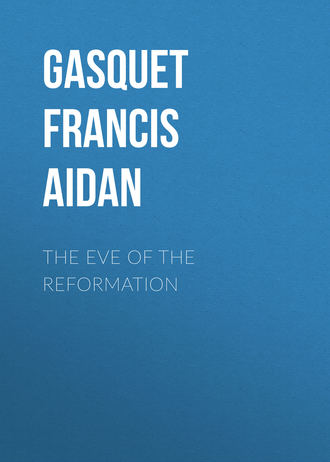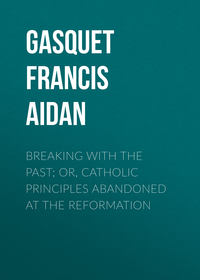 полная версия
полная версияThe Eve of the Reformation
350
Testamenta Eboracensia (Surtees Society), vol. iv. p. 21.
351
Ibid., p. 127.
352
Ibid., p. 127.
353
Ibid., p. 170.
354
Ibid., p. 27.
355
Ibid., p. 60.
356
Ibid., p. 335.
357
Ibid., p. 277.
358
Ibid., p. 139, seqq.
359
Ibid., p. 61 and note.
360
Ibid., p. 69.
361
Ibid., p. 89.
362
Ibid., p. 132.
363
Ibid., p. 149.
364
Ibid., p. 208.
365
Ibid., p. 215.
366
Ibid., p. 230.
367
Ibid., p. 119.
368
Ibid., p. 160.
369
B. Mus. Harl. MS. 670, f. 77 b.
370
Yorkshire Chantry Surveys (Surtees Soc.), ii., preface, p. xiv.
371
The Economic Interpretation of History, p. 306.
372
J. S. Burn, History of Henley on Thames, pp. 173-175.
373
R. O. Chantry Certificate, No. 13 (account for year 37 H. VIII.), No. 17.
374
Ibid., No. 30 and No. 95, M. 6.
375
Ibid., No. 37, M. 12; also No. 95, M. 7; and No. 13 (38) Mins. Accts. 2, 3, Ed. VI., shows that the king received £11, 19s. 8d. for the property of this chapel, which was granted to Robert Swift and his brother.
376
R. O. Chantry Certificate, No. 45 (m. i. d.).
377
Ibid.
378
Ibid.
379
Ibid. (18).
380
Ibid. (20).
381
This was owing to the recent dissolution of the Abbey.
382
In one case it is said: “Mem.: The decay of rent is caused by the fact that most came from lands in possession of the abbey; since the dissolution these have been sold, and the purchasers do not allow that they are liable to pay.” The hospital called St. Parvell’s, without the south gate, also had been dissolved by Henry VIII., and the property granted to Sir George Somerset (6th July, 37 H. VIII.). It had produced £16, 13s. 4d. a year, with £5, 10s. “paid out of the late abbey of Bury to the sustentation of the poor.” The whole charity, of course, by the dissolution of the abbey and the grant of the remaining property as above, had come to an end.
383
Ibid. (No. 44).
384
Yorkshire Chantry Surveys (Surtees Soc.), p. 213.
385
Ibid., p. 214.
386
Ibid., p. 215.
387
Ibid., p. 216.
388
Ibid., p. 11.
389
Ibid., p. 12.
390
Ibid., p. 13.
391
Gentleman’s Magazine, vol. lxxxii., ii. 318. Quoted in J. Gough Nichol’s Pilgrimages, &c. Introduction, xcv.
392
Lancelot Rydley. Exposition in the Epistell of Jude. London, Thomas Gybson, 1538, sig. B. v. In sermons and writings, pre-Reformation ecclesiastics strove to impress upon the minds of the people the true principles of devotion to shrines and relics of the saints. To take one example beyond what is given above. In The Art of Good Lyvyng and Good Deyng, printed in 1503, the writer says: “We should also honour the places that are holy, and the relics of holy bodies of saints and their images, not for themselves, but for that in seeing them we show honour to what it represents, the dread reverence, honour and love of God, after the intention of Holy Church, otherwise it were idolatry” (fol. 6).
393
A Commentary in Englyshe upon the Ephesians, 1540, sig. A. ii.
394
P. 190.
395
Opera omnia (ed. Leclerc), tom. v., col. 26.
396
Col. 37.
397
A treatise concerning the division between the spiritualitie and the temporalitie. London, R. Redman (1532?), fol. 27.
398
Dyaloge in Englyshe, 1531. Part 3, fol. 23.
399
English Works, p. 476.
400
Stephen Gardiner. A declaration of such true articles as George Joye hath gone about to confute as false. 1546, f. 2.
401
Consilium de emendanda ecclesia (Ed. 1538), sig. B. 4.
402
Jacobi Sadoletti, Opera Omnia, Verona (1737). Tom ii., p. 437.
403
It is said to be “printed at Jericho in the land of Promes, by Thomas Treuth.”
404
The English Testament.
405
Sig. A. 3.
406
Ibid., sig. A. 4.
407
Ibid., sigs. A. 5 d., A. 6 d.
408
Ibid., sig. B. i.
409
Ibid., sig. B. ii.
410
Ibid., sig. B. viii.
411
Sig. D. vii.
412
Ibid., sig. D. viii.






